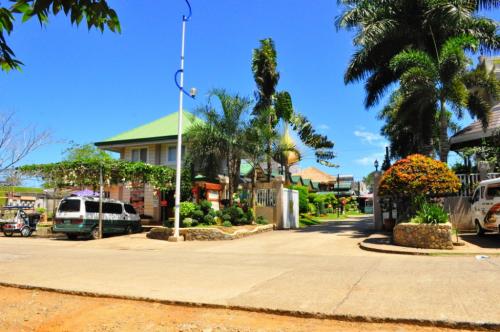Malolos
The Barasoain Church, also known as Our Lady of Mount Carmel Church, is laden with history. Considered as a National Shrine, the historic church is the site of the Constitutional Convention of the first Philippine Republic, making the Philippines the very first Asian Government to promulgate a Constitution. It was the Seat of the First Philippine Republic on Sept. 15, 1898 to the last week of Feb. 1899 under the presidency of Pedro Paterno. In its convent the Universidad Literaria Cientifica de Filipinas was first housed. It also boasts of a light and sound museum under the management of National Historical Institute. The Barasoain Church consists of two structures: the church and the adjoining convent. The architecture engages visitors with its curved facade, rose window and medieval bell tower. Floral motifs and frescoes of angels and saints adorn the interior. It has paintings in its ceilings and domes which make it look bigger than its actual size. After the original church was destroyed by fire in 1884, the structure underwent several renovations. The way it looks today is not too different from how it looked during the time of Emilio Aguinaldo. The Barasoain Church Historical Landmark is located in the heart of Malolos, Bulacan. Just 42 kilometers from Manila, it is easily accessible by public transportation. Sources:Experience BulacanWikipedia.org
Malolos
Barasoain Ecclesiastical Museum is located in San Gabriel, Malolos City, Bulacan, Philippines. A museum managed by National Historical Institute showcasing a collection of municipal antiques and priceless array of artifacts. Source:Bulacan.gov.ph
Barili
Candugay and Sayaw are Barili's most popular beaches. Tourists and locals constantly swarm these beaches for it white sand, clear blue waters, and inexpensive rates. Beaches in Barili are still untouched by commercialization and modern developments. Native cottages for day picnics are rented out at the most affordable rates. Source:Cebu Beaches
San Fernando (La Union)
Baroro Bridge Marker is located in San Fernando, La Union, Philippines. The siege of Baroro in Bacnotan started the operation to liberate San Fernando. This marked the first victory of the Luzon Guerillas over a Japanese armed unit before the American Liberation forces landed on Luzon. The marker stands at the southern approach of the bridge approximately 14 kilometers north of San Fernando. Source:Wowphilippines.com.ph
Palawan
Barracuda Lake is located near the Kayangan Lake, it is also a Hall of Fame Awardee for the Cleanest and Greenest Lake in the country. Its name is derived from a story passed on from generation to generation that two giant barracudas live in the lake. But its allure lies in its shimmering emerald waters. Source:Palawan.gov.ph
Iloilo
Make sure to include Barrio Inasal on your quest for the best chicken barbecue or inasal in Iloilo, Food, ambiance, service... this restaurant is purely pinoy. The specialty of this restaurant of course is Chicken Inasal or Chicken Barbecue, following are Grilled Managat, Grilled Squid, Sinigang Bulgan, and Sinigang Lison to name a few. Barrio Inasal makes sure that everything that is put to your table is fresh, the secret to best tasting food. As for the beverages, a personal favorite is the Green Mango Shake, a perfect way to drown a hot day away. The interior of the restaurant is Filipino themed with wooden tables and benches plus the generic native décor.
Bongabon
Barrio Labi is located in the town of Bongabon, along the National Highway going to Baler, Quezon, this is the death place of Mrs. Aurora Aragon Quezon, the wife of the late President Manuel Luiz Quezon. Source:Nuevaecija.gov.ph
Carranglan
Barrio Puncan is located at Carranglan, Nueva Ecija, Philippines. The place is known to be the “Little Baguio of Nueva Ecija” for its cool breeze atmosphere and pine trees. Source:Nuevaecija.gov.ph
Olongapo
Bart's Beach is located in Olongapo.
Cebu City
The convent of the Sto. Niño de Cebu was founded on April 28, 1565 , the very day the Legazpi-Urdaneta Expedition arrived in the island. On May 8 of the same year, when Legaspi and his men planned the urbanization of the city, they allotted a place for the church and the convent of San Agustin, where the Santo Niño image had been found. In 1599, the convent was made a house of studies of grammar. It also served as a rest house for missionaries working in the province and as a retirement home for the aged and the sick, usually attended to by a lay brother. The stones used in the construction of the church were quarried from Capiz and Panay by an army of bancas. The molave wood came from the mountains of Talisay and was transported in bancas. Despite the seemingly impossible task, Fr. Albarran was not discouraged. He used white stones to make the lime, with one banca transporting some 400 pieces of stones. There was also another obstacle: the lack of chief craftsmen and officers which forced Fr. Albarran to acquire some knowledge of architecture. The church was finished not later than 1739. According to an author named Vela, “the church has all the characteristics of a solid construction to withstand all the earthquakes…….” And true enough, the church withstood all earthquakes. The original features of the church have been retained except for the windows added by Fr. Diez in 1889. In 1965, both church and convent underwent a bigger restoration on the occasion of the fourth centennial of the Christianization of the country. The face lifting was made with utmost respect for the historical character of the old structure. Cardinal Hildebrando Antoniutti, Papal Legate to the Philippines , conferred upon the church the title of Basilica minore , a special privilege granted to the Augustinian Order by the Pope Paul VI. On the other hand, the former President Ferdinand Marcos declared the Sto. Niño Basilica a national shrine because of its historical significance. Source:Basilica del Santo Niño de Cebu
